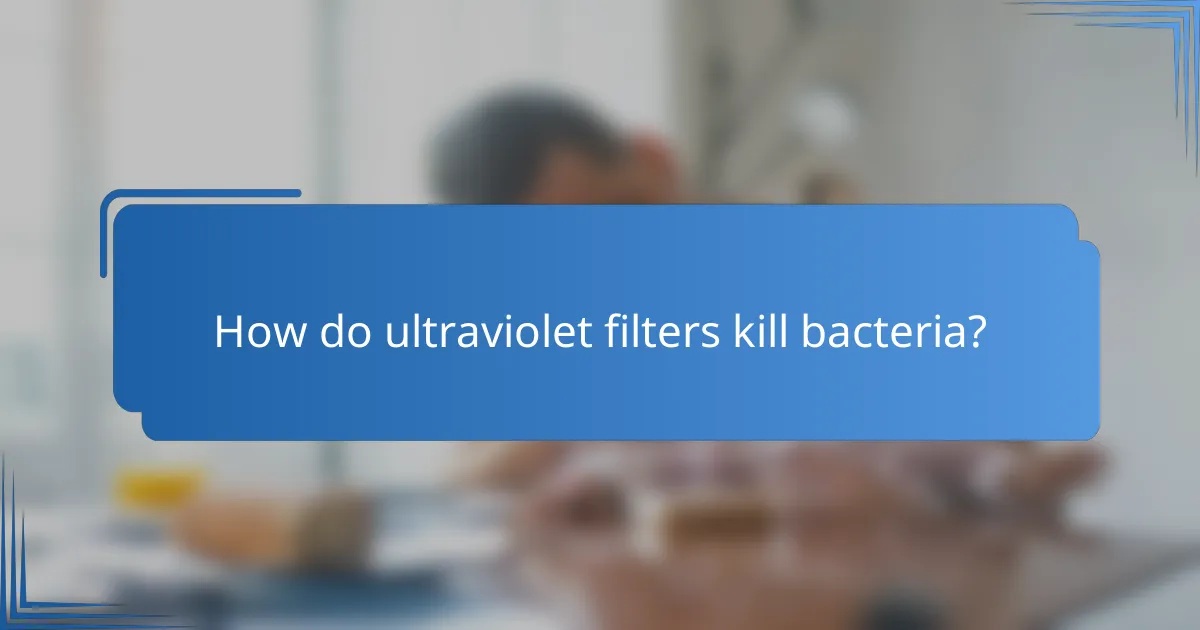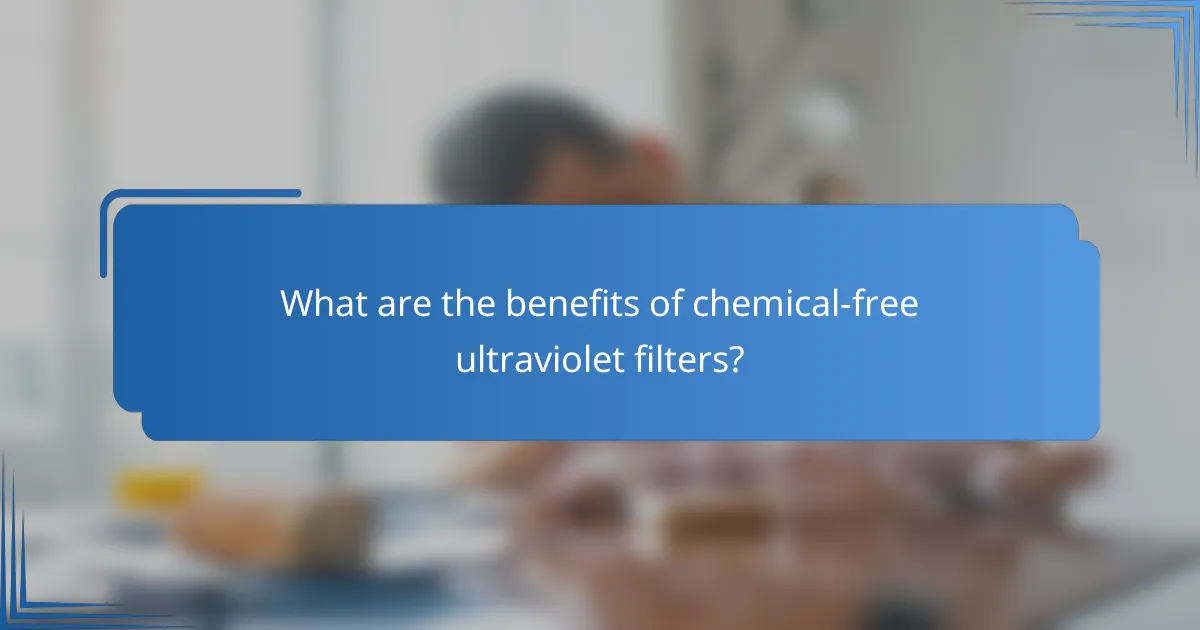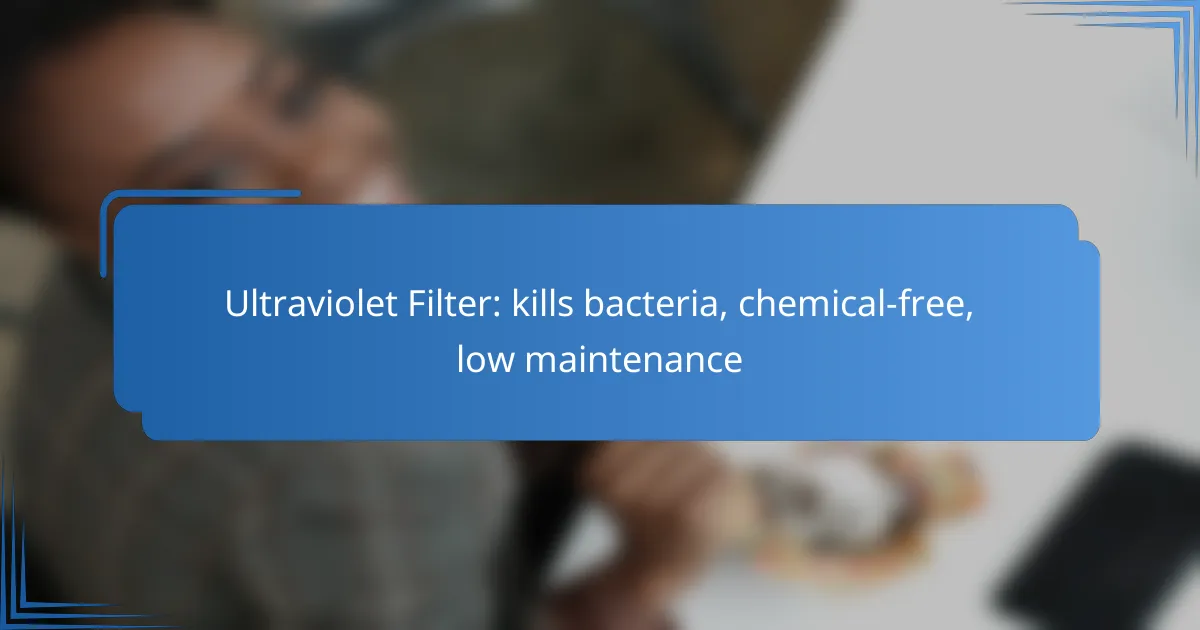Ultraviolet (UV) filters provide a chemical-free solution for killing bacteria by using UV light to disrupt their DNA, making them unable to reproduce. This low maintenance method is ideal for various water purification systems, offering effective microorganism elimination while minimizing environmental impact.

How do ultraviolet filters kill bacteria?
Ultraviolet (UV) filters kill bacteria by using UV light to disrupt their DNA, rendering them unable to reproduce and effectively neutralizing them. This chemical-free method is low maintenance and can be integrated into various water purification systems.
Mechanism of action
UV filters emit light at specific wavelengths, typically around 254 nanometers, which is highly effective at penetrating the cellular structure of bacteria. When bacteria absorb this UV light, it causes damage to their DNA, preventing replication and leading to cell death. This process is rapid, often taking just a few seconds to achieve significant bacterial reduction.
The effectiveness of UV filters relies on factors such as water clarity and flow rate. Clear water allows for better UV penetration, while high flow rates can reduce exposure time, diminishing effectiveness. Regular maintenance of the UV system is essential to ensure optimal performance.
Effectiveness against pathogens
UV filters are effective against a wide range of pathogens, including bacteria, viruses, and protozoa. Studies indicate that UV light can inactivate over 99% of common waterborne pathogens, making it a reliable choice for water treatment. However, certain microorganisms, like some spores, may require higher doses of UV light for complete inactivation.
For practical applications, UV filters are often used in municipal water systems, aquariums, and even home water purification units. Their effectiveness can vary based on the specific pathogens present and the design of the UV system.
Comparison with traditional methods
Compared to traditional methods like chlorination, UV filters offer several advantages. They do not introduce chemicals into the water, avoiding potential taste and odor issues. Additionally, UV treatment does not create harmful byproducts, which can be a concern with chemical disinfection.
However, UV filters require electricity to operate and do not provide residual disinfection, meaning they do not protect against recontamination after treatment. In contrast, chlorination can maintain a disinfectant residual in the water supply. Therefore, combining UV treatment with other methods may enhance overall water safety.

What are the benefits of chemical-free ultraviolet filters?
Chemical-free ultraviolet filters offer several advantages, including effective bacteria elimination, low maintenance requirements, and a reduced environmental footprint. These filters utilize UV light to kill microorganisms without the need for harmful chemicals, making them a safe choice for water purification and air treatment.
Health advantages
One of the primary health benefits of chemical-free ultraviolet filters is their ability to eliminate harmful bacteria and viruses from water and air. By using UV light, these filters effectively neutralize pathogens without introducing any chemical residues that could pose health risks. This is particularly important for households with children or individuals with compromised immune systems.
Additionally, UV filters help maintain the quality of drinking water by preventing the growth of biofilms and other contaminants. This ensures that the water remains safe and clean, promoting overall health and well-being.
Environmental impact
Chemical-free ultraviolet filters have a significantly lower environmental impact compared to traditional chemical treatments. They do not produce harmful byproducts, which can contaminate water sources and harm aquatic life. By relying on UV light, these systems contribute to a cleaner ecosystem.
Moreover, the energy consumption of UV filters is generally lower than that of chemical processes, leading to reduced carbon emissions. This makes them a more sustainable option for both residential and commercial applications.
Cost-effectiveness
Investing in chemical-free ultraviolet filters can be cost-effective in the long run. While the initial purchase price may be higher than traditional systems, the lack of ongoing chemical purchases and lower maintenance costs can lead to significant savings over time. Users often find that they spend less on replacements and repairs due to the durability of UV systems.
Additionally, many UV filters have long lifespans, often lasting several years with minimal upkeep. This means fewer replacements and reduced waste, making them a financially savvy choice for environmentally conscious consumers.

What is the maintenance required for ultraviolet filters?
Ultraviolet filters require minimal maintenance, primarily focusing on cleaning and occasional replacement. These filters are designed to be efficient and effective in killing bacteria without the need for chemical treatments.
Cleaning procedures
Regular cleaning of ultraviolet filters is essential to maintain their effectiveness. Typically, this involves wiping down the exterior surfaces and ensuring that the UV lamp is free from dust and debris. Depending on the environment, cleaning may be needed every few weeks to months.
For optimal performance, check the manufacturer’s guidelines for specific cleaning recommendations. Avoid using harsh chemicals that could damage the filter or interfere with its function.
Replacement frequency
Replacement of ultraviolet filters generally depends on the type and usage, but most UV lamps should be replaced every 12 to 24 months. Regularly checking the lamp’s output can help determine if it needs replacement sooner.
Some systems include indicators that alert users when the UV lamp is nearing the end of its lifespan. Adhering to these timelines ensures continued effectiveness in bacteria elimination.
Longevity of filters
The longevity of ultraviolet filters can vary based on usage and environmental factors. Typically, UV lamps last between 9,000 to 12,000 hours of operation, translating to about one year of continuous use.
Factors such as water quality, temperature, and exposure to contaminants can affect the lifespan. Regular monitoring and maintenance can help extend the life of the filter and ensure optimal performance.

How do ultraviolet filters compare to other water purification methods?
Ultraviolet filters are effective at killing bacteria and other pathogens without the use of chemicals, making them a popular choice for water purification. Compared to other methods, they offer low maintenance and a straightforward operation, but each method has its own advantages and limitations.
Comparison with activated carbon filters
Activated carbon filters excel at removing chlorine, sediment, and volatile organic compounds (VOCs) from water, improving taste and odor. However, they do not effectively kill bacteria or viruses, which is where ultraviolet filters shine. For comprehensive purification, using both methods in tandem can provide cleaner water.
While activated carbon filters require regular replacement every few months, ultraviolet systems typically need less frequent maintenance, mainly focusing on bulb replacement annually. This makes UV filters a more convenient option for ongoing bacterial control.
Comparison with reverse osmosis systems
Reverse osmosis (RO) systems are highly effective at removing a wide range of contaminants, including heavy metals and salts. However, they can be slow and waste significant amounts of water during the purification process. In contrast, ultraviolet filters work quickly and do not produce wastewater, making them a more efficient choice for pathogen elimination.
RO systems often require a more complex installation and maintenance routine, while UV filters are simpler to set up and operate. For households concerned primarily with bacteria and viruses, UV filters can be a low-maintenance alternative to RO systems.
Comparison with chlorine treatment
Chlorine treatment is a traditional method for disinfecting water, effectively killing bacteria and viruses. However, it can leave a chemical taste and odor, and some people may be sensitive to chlorine. Ultraviolet filters, on the other hand, provide chemical-free purification, preserving the water’s natural taste.
Chlorine can also react with organic matter in water, forming potentially harmful byproducts. In contrast, UV filters do not create these byproducts and are safer for long-term use. For those looking to avoid chemicals, UV filtration is a compelling alternative to chlorine treatment.

What are the best ultraviolet filter brands available in the market?
Some of the best ultraviolet filter brands include SteriPEN, Viqua, and Aqua Ultraviolet. These brands are known for their effectiveness in killing bacteria without the use of chemicals, making them low-maintenance options for water purification.
Brand one: SteriPEN
SteriPEN is a popular choice for portable UV water purification. It uses ultraviolet light to destroy over 99.9% of harmful microorganisms in water, making it ideal for outdoor activities and travel. The device is compact and easy to use, often requiring just a minute or two to purify a liter of water.
When using SteriPEN, ensure that the water is clear, as turbidity can affect its efficiency. The device typically operates on batteries, so consider carrying spares for extended trips.
Brand two: Viqua
Viqua specializes in UV water treatment systems for residential and commercial use. Their systems are designed to be installed at the point of entry, providing treated water throughout the entire building. Viqua units are effective against bacteria, viruses, and protozoa, ensuring safe drinking water.
Installation usually requires professional assistance, and maintenance involves replacing the UV lamp annually. Viqua systems are compliant with various health regulations, making them a reliable choice for households.
Brand three: Aqua Ultraviolet
Aqua Ultraviolet focuses on UV systems for aquariums and ponds, ensuring clean water for aquatic life. Their products are designed to eliminate algae and harmful pathogens, contributing to a healthier environment for fish and plants. Aqua Ultraviolet systems are available in various sizes to suit different applications.
Regular maintenance includes cleaning the quartz sleeve and replacing the bulb as recommended. These systems are effective in both freshwater and saltwater environments, making them versatile for different users.

What factors should be considered when choosing an ultraviolet filter?
When selecting an ultraviolet (UV) filter, consider flow rate, UV lamp lifespan, and system compatibility. These factors significantly impact the filter’s effectiveness, maintenance needs, and integration with existing systems.
Flow rate
Flow rate refers to the volume of water that passes through the UV filter per unit of time, typically measured in liters per minute (L/min) or gallons per minute (GPM). It’s crucial to choose a filter that matches your water usage to ensure effective disinfection. For residential systems, flow rates often range from 5 to 30 GPM, depending on household size and usage.
Higher flow rates can reduce the contact time between water and UV light, potentially decreasing effectiveness. Always check the manufacturer’s specifications to ensure the filter can handle your expected flow rate while maintaining adequate UV exposure.
UV lamp lifespan
The lifespan of a UV lamp is an important consideration, as it directly affects maintenance frequency and costs. Most UV lamps have a lifespan of around 9,000 to 12,000 hours, translating to about one year of continuous use. After this period, the lamp’s effectiveness diminishes, requiring replacement to ensure optimal performance.
Regularly monitoring the lamp’s output and replacing it as needed can prevent bacterial growth in your water supply. Some systems include indicators to alert users when it’s time for a replacement, which can simplify maintenance.
System compatibility
Ensuring that the UV filter is compatible with your existing water treatment system is essential for seamless integration. This includes checking the size, connection types, and electrical requirements of the UV unit. Most filters are designed to fit standard plumbing sizes, but it’s wise to confirm before purchase.
Additionally, consider any pre-treatment requirements, such as sediment filters, which may be necessary to protect the UV system from particulates that could hinder its effectiveness. Compatibility with your water source and other treatment methods will enhance overall water quality and system efficiency.
